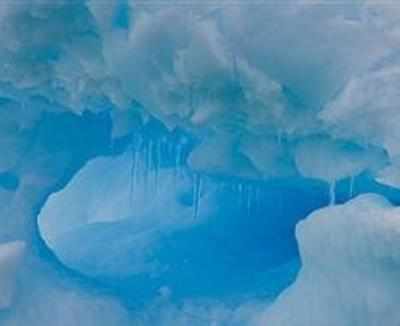- News
- India to probe Antarctic waters with ROV developed by Chennai lab
This story is from December 26, 2014
India to probe Antarctic waters with ROV developed by Chennai lab
This new year, India will begin underwater expedition of the Antarctic region using a remotely operable vehicle (ROV) developed by Chennai-based National Institute of Ocean Technology (NIOT). Samples collected from the underbelly of icebergs, which could be millions of years old, may hold potential surprises, including clues on origin of life.

This new year, India will begin underwater expedition of the Antarctic region using a remotely operable vehicle (ROV) developed by Chennai-based National Institute of Ocean Technology (NIOT). Samples collected from the underbelly of icebergs, which could be millions of years old, may hold potential surprises, including clues on origin of life.
CHENNAI: This new year, India will begin underwater expedition of the Antarctic region using a remotely operable vehicle (ROV) developed by Chennai-based National Institute of Ocean Technology (NIOT). Samples collected from the underbelly of icebergs, which could be millions of years old, may hold potential surprises, including clues on origin of life.
The ROV, which is fitted with cameras and mechanical devices, will collect samples from under icebergs.It will also capture images underwater. “While the upper part of ice which is exposed to air keeps changing, the bottom part remains relatively intact. Some of the samples from the bottom of icebergs could be millions of years old,” said NIOT director M A Atmanand.
India, which has two permanent research stations – Maitri and Bharti – has been sending ships to the south pole, but this will be the first time an ROV will be deployed for underwater research. Officials said the shallow water ROV has been designed specifically for the polar region. Unlike India’s ROVs which can go up to 6,000m under sea in the Central Indian Ocean, the polar ROV, which is much smaller, can dive up to 300m.
Atmanand said the expedition will begin in January. The team comprising scientists of NIOT and National Centre for Antarctic and Ocean Research (NCAOR) has undergone acclimatization training in the Himalayas. “December and January are the summer months at the poles, and the ROV has been sent from Goa via Cape Town. The team will leave next month,” he said. The National Centre for Antarctic and Ocean Research (NCAOR), a research and development body, controls the Indian Antarctic Programme.
The corer attached to the vehicle collected samples of a few manganese nodules. It also gathered data such as temperature, sound velocity, conductivity, density and dissolved oxygen. The ROV was within the 75,000sqkm area in the Central Indian Ocean Basin allotted to India by the International Sea Bed Authority of the UN for harnessing polymetallic nodules.
In July 2014, a multi-sensor moored observatory, IndARC, which is the country’s first, designed by ESSO-NIOT and ESSO-NCAOR with ESSO-Indian National Centre for Ocean Information Services (INCOIS), Hyderabad was successfully deployed in Kongsfjorden Fjord of the Arctic, between North Pole and Norway.
The ROV, which is fitted with cameras and mechanical devices, will collect samples from under icebergs.It will also capture images underwater. “While the upper part of ice which is exposed to air keeps changing, the bottom part remains relatively intact. Some of the samples from the bottom of icebergs could be millions of years old,” said NIOT director M A Atmanand.
India, which has two permanent research stations – Maitri and Bharti – has been sending ships to the south pole, but this will be the first time an ROV will be deployed for underwater research. Officials said the shallow water ROV has been designed specifically for the polar region. Unlike India’s ROVs which can go up to 6,000m under sea in the Central Indian Ocean, the polar ROV, which is much smaller, can dive up to 300m.
Atmanand said the expedition will begin in January. The team comprising scientists of NIOT and National Centre for Antarctic and Ocean Research (NCAOR) has undergone acclimatization training in the Himalayas. “December and January are the summer months at the poles, and the ROV has been sent from Goa via Cape Town. The team will leave next month,” he said. The National Centre for Antarctic and Ocean Research (NCAOR), a research and development body, controls the Indian Antarctic Programme.
Earlier, the Institute developed a remotely operable vehicle (ROSUB 6000) which reached the sea bed of Central Indian Ocean at a depth of 5289m in April 2010. The submersible equipped with seven cameras and mechanical devices took photographs of the seabed.
The corer attached to the vehicle collected samples of a few manganese nodules. It also gathered data such as temperature, sound velocity, conductivity, density and dissolved oxygen. The ROV was within the 75,000sqkm area in the Central Indian Ocean Basin allotted to India by the International Sea Bed Authority of the UN for harnessing polymetallic nodules.
In July 2014, a multi-sensor moored observatory, IndARC, which is the country’s first, designed by ESSO-NIOT and ESSO-NCAOR with ESSO-Indian National Centre for Ocean Information Services (INCOIS), Hyderabad was successfully deployed in Kongsfjorden Fjord of the Arctic, between North Pole and Norway.
End of Article
FOLLOW US ON SOCIAL MEDIA
